Dear Reader, in this age of AI created content, please support with your goodwill someone who works harder to provide the human-made. Sign up at the top of the lefthand column or bottom of this page. You will receive my hand illustrated monthly newsletter RESTORE NATURE and access to the biodiversity garden design course as I write...and nothing else, I respect your time. I am also removing the advertizing as best I can as its become intrusive inappropriate and pays me nothing.
How to save water in the home
 To work out how to save water we need to consider all water streams coming in and going out of a home or property.
To work out how to save water we need to consider all water streams coming in and going out of a home or property.Make an urban oasis with grey water !
On special offer for just one week
my book
"DIY Gray Water Wetland" !
A message to all readers ! Should you want to buy the book which I have just published, I am making a special offer. For one week only, it will be available free of charge. I'm releasing the book free for this short time, to give potential readers a chance to buy and review. We really need some reviews to market the book properly, so that potential buyers are informed of its content and can make the right choices. Your intelligent input will be a great help, and really appreciated. I read all my reviews and it will really help with future writing.
The water streams that enter and leave an urban home
The major household water streams that enter an urban home are mains water and rain water, and with a little extra investment, borehole water. You could say that all water that exits the house walls is either grey or black waste water, and that which exits the property is waste water, irrigation or runoff. To play our part in reducing water consumption on a city wide scale, we need to reduce the mains water we are using. One can do this just by restricting water usage. Often looking at the other water supply streams, like rain and borehole water, and waste water streams like black, grey, and storm water can also help accomplish this. A multi pronged approach is probably the most effective.
In an urban home with good water supply, about half of the water used inside is for flushing and half for other purposes. That is, about half becomes grey water, and half black water. These are mixed underground outside the house walls in the waste water stream leaving the home. With low flow fixtures and appliances water use can be cut to about a third. Then the grey water comprises more than half of the waste water stream.
The problem with borehole water
Borehole water is often used to supplement water consumption from the mains, but it does not really reduce water consumption. It
comes from a shared source, tapped into by all the people withdrawing
water from the water table or aquifer. When you take water from a water
body, be it a surface river or underground source, there is less water for other people. In
very dry areas this is most marked. Sometimes the water tapped is ancient fossil water, and not renewable within historical time. When Cape Town was in drought, many boreholes were sunk. This did not help the problem. Removing deep underground water just dries out the whole region to a deeper level, and boreholes eventually have to be sunk deeper and deeper. When aquifers close to the coast are stressed by too many people using them, the salt water from the sea can be sucked in to refill them. For this reason I am very much against boreholes. I do not think massive use of boreholes in urban areas is sustainable. It also does not teach people to be extremely conservative with water. It can just lead to extravagant use of mains water being translated to extravagant use of borehole water. We do need to reduce the amount of water we consume. Others may disagree but I felt duty bound as a permaculturist to do without a borehole.
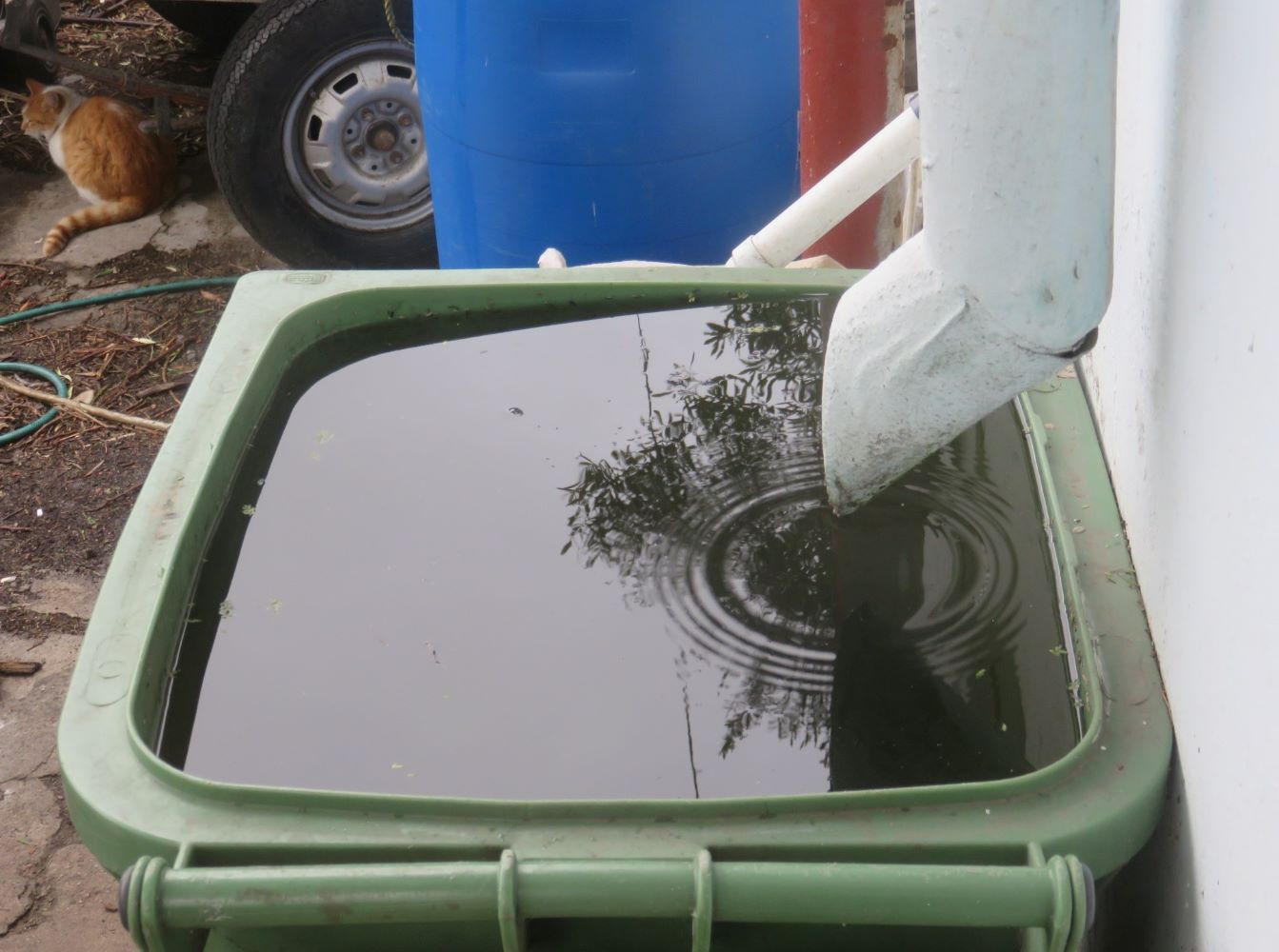 How to save free water from the sky. Use whatever rain tanks you can afford. But recharge the groundwater too. This tank was a refuse bin.
How to save free water from the sky. Use whatever rain tanks you can afford. But recharge the groundwater too. This tank was a refuse bin.Rain water
Rain water enters your property without any surcharges. It should be free to use, but there are also social, as in shared, communal and environmental things to consider. If someone were to catch every drop falling on their property and empty it into the waste water channels it will go far away and out to sea. They would be robbing the landscape in the area of this water source. This means they are reducing water available for vegetation and underground streams and contributing to drying out the suburb they live in and setting up the preconditions for drought. However, if this person were to harvest rain water in tanks, and let the same amount of water back out into the landscape after use, it would not be subtracted from the local landscape. The cumulative effect of many many households subtracting water through boreholes and rain collection could desiccate an area and worsen drought, even if everyone knows how to save water and water conservation methods are rigorously applied.
There are many alternatives for using rain water before it re-enters the earth. With investment in tanks, one can catch it and put it through the house, supplanting mains water. Thorough filtration to remove contaminants and sanitizing of the water with heat or filters, and re-mineralization the drinking water are good for domestic use of the rain water stream. One needs to take care then that the grey water is fed back into the earth, and there is no black waste water in order not to subtract water from the landscape and do environmental damage. The grey water needs to be free of persistent pollutants, sanitizing chemicals and saline elements and passing it through a biofilter will help accomplish this. I have built two such biofilters and written about how to construct them. For more information there is a link at the top of the right side bar to my book on building a DIY grey water wetland.
One can also catch the rain water for the garden only. This means it is caught once, and then distributed over the garden and enters the ground water. This is a case not of multiple uses of the rain water, but of delayed or distributed use. By building tanks for catching rain, rainfall on the garden can be supplemented by saved water at regular intervals, sustaining plants with more intense water demands than native plants. Water can also be distributed through time and space, with contour channels in the ground made of earth called swales. Every time it rains the swales lead water to all ends of the property and this allows the rain to sink into the ground evenly and hydrate the soil. Without swales, rain may fall and rush down the well worn rain channels like stream beds or drive ways and leave the property without penetrating into the garden soil. Swales also spread the water in the garden so that it doesn't accumulate around houses and walls. They distribute the water through space and time because they allow the absorption and slow release of water over a large area.
The rain water on our property mainly
flows down the drive and into the garden, or into small rain tanks which feed the fish ponds, which are drained into the garden eventually. I found in the urban context of a tiny cramped
garden, that was roughly level, and built on deep sand, that earth
swales were not going to distribute water. Much to my chagrin
I'm designing a compromise with a much less permeable material to conduct
water along contours, namely perforated plastic piping. Perhaps un-mortared brick swales lined with clay to
increase their water holding capacity would work in this context, to avoid plastic.
How to save water coming
from the mains
As said, to save mains water one should use a combined strategy of supplementing it with other streams and reducing actual usage of water with self restraint, and perhaps water flow reducing devices on toilets, showers, appliances and the like.
Recycling grey water can help reduce mains water consumption. In my book on the DIY grey water wetland I describe the different types of end use of water, and how this can be dovetailed with water supply from various grey water sources. There is more on grey water recycling in another specialized article.
Mains water quality
The water coming through pipes is supplied by the city mains. The mains water comes charged with chlorine to prevent outbreaks of disease. Chlorine and the numerous other contaminants in piped drinking water cause disease in the long run, over decades. The cause and effect plays out in a less obviously connected way in slow chronic suffering. In the US up to 200 different species of metal ions, hydrocarbons, biocides and more have been recorded in drinking water. This is why drinking water is listed as one of the most dangerous sources of exposure to environmental toxins that are disease causing.
To get rid of some contaminants we flush 15 liters of our tap water through to the ponds, before storing 10 liters of what comes from the tap for drinking. This is the cheapest type of water filter supplement. It removes a lot of contaminants which originate in the piping, like plastic ingredients and metals. But it does nothing to remove the contaminants coming from the large municipal mains. Our water is stored outside in glass bottles in bright sunlight for two days to keep it sanitized, and remove chloramines, but ideally it should also be filtered. Inside it is also stored in glass. Plastic can release contaminants into the water. We never use mains water for irrigation. The reason being that many plants do not take kindly to being doused with chlorinated water. It probably kills the soil microbiome around the plant roots and thus the nutrient supply of the plant. If tap water is left standing for a few days in a bucket, or it is put through a fish pond, it loses the chlorine and becomes very plant friendly. Since using pond water we have no more plant losses due to chlorine.
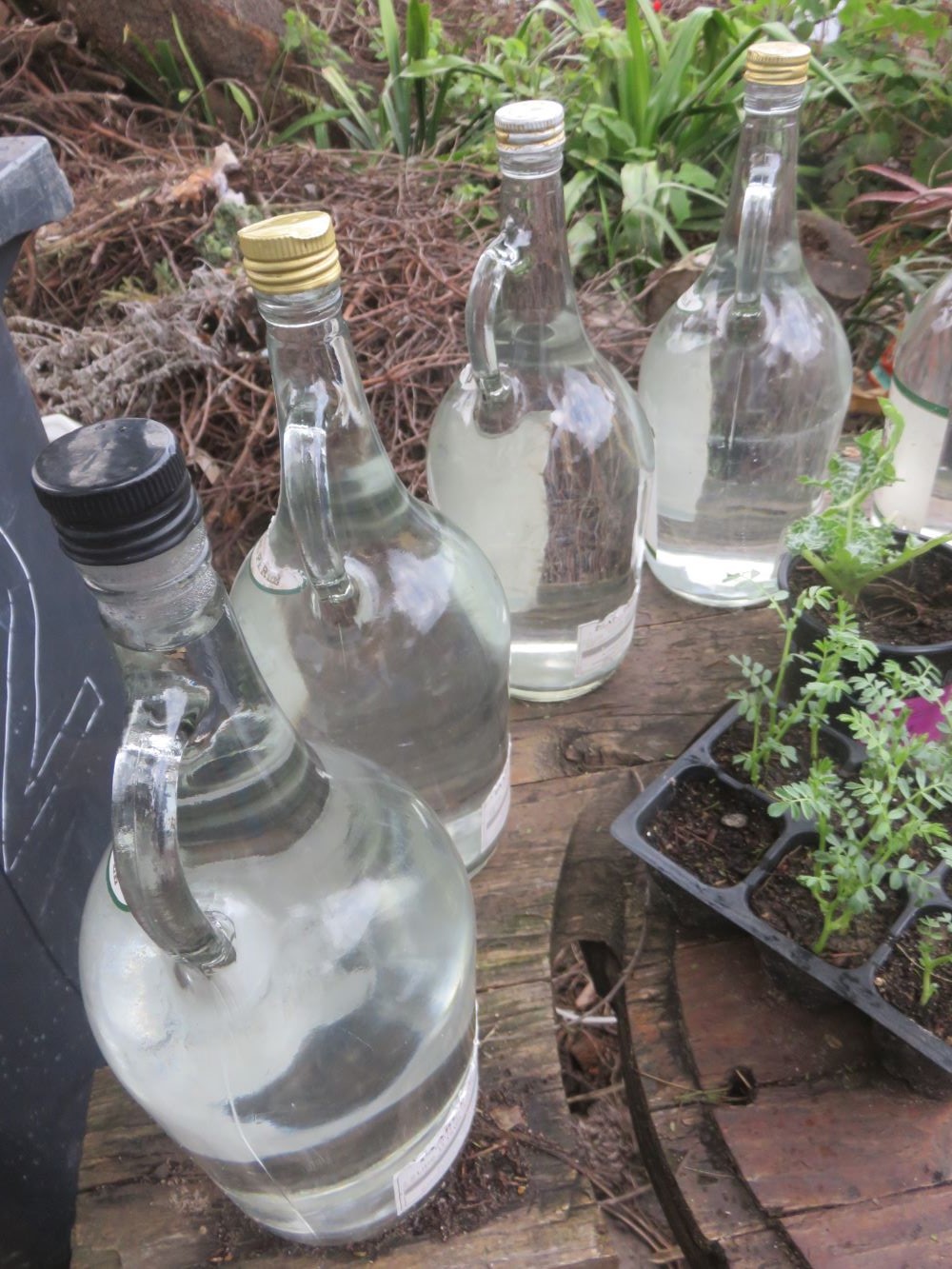 step 1 in the sun step 1 in the sun |
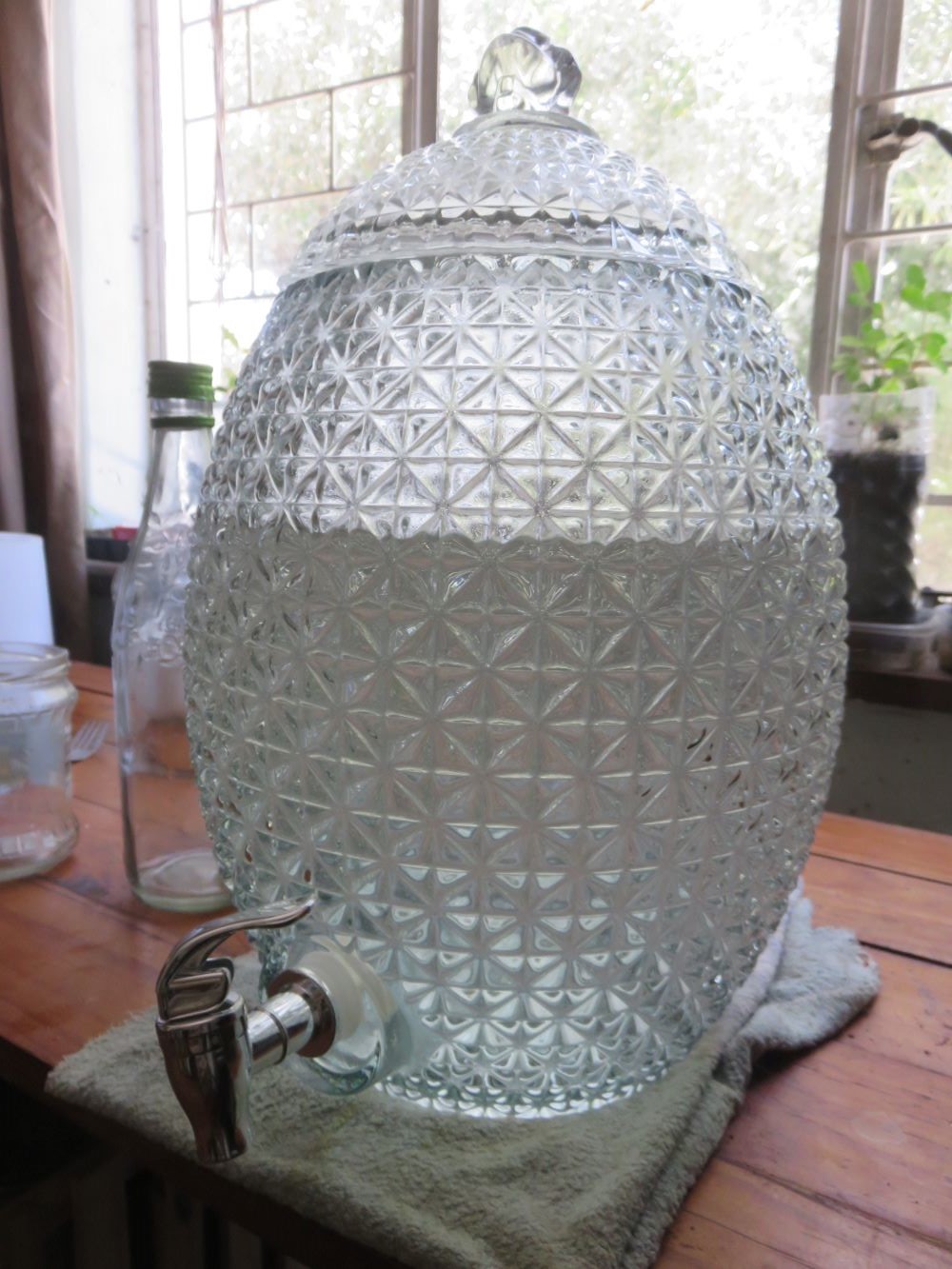 step 2 also glass step 2 also glass |
Streams moving away from the home: runoff and irrigation
Generally runoff will end up in storm water drains, which are also seen as a form of 'waste' water. Runoff from rain can actually be harvested off streets and driveways and other hard surfaces, just as rain is harvested off the roof. It can be led into swales, or tanks, but contamination from street dirt needs to be considered, and some filtration would be good before storing it in tanks to prevent it going bad.
Irrigation water let into the ground is also moving through the environment away from the home. But of course it travels vertically down instead of sideways across the land. As the water moves down through the soil it is cleaned by sand filtration and microorganisms and excess nutrients can be absorbed by tree roots. The soil can be seen as the greatest water filter.
However this enormous filter can also reach capacity. Very contaminated water, for example water containing too much salt, phosphates, nitrates, petrochemicals and pathogens, can exceed the soil's capacity to 'metabolize' contaminants, and they will find their way into the ground water, the rivers and the oceans. Salt can make soil infertile, but if it reaches deep soil it is no longer a threat, and it doesn't endanger rivers and water systems in general. Contaminants such as phosphates and nitrates can wreak havoc on natural ecosystems, upsetting the nutrient balance, over nutrifying and causing eutrophication or the death of natural water bodies, petrochemicals can poison water life and disrupt breeding cycles, and pathogens can cause human epidemics.
Releasing of grey water into the ground to replace rain water that has been harvested is part of a water saving strategy, and maintaining the water status of your whole landscape and catchment.
Another stream of water leaving the home is one which
needs to be distinguished from grey water, namely black water.There are a number of possible savings here too.
Black water
Black water is composed of feces, urine and flushing water. Flushing water is a major consumer of water in the home. The flushing water can be saved by using reduced flow devices, flushing with recycled grey water, or it can be eliminated with 'dry' toilets.
In a rural setting, the black
water stream often is recycled on site. If there is no dry toilet
system in place it will usually pass through a septic tank, and the
outflow can be used for growing certain kinds of plants. In Germany
there is an eco village where the black water flows into big lined
settling dams full of reeds, before flowing back into the landscape.
The same is used on a large scale with city clarification plants. I think it would be possible to use this type of water on a small scale for growing food plants
with a high water and nutrient demand. What works well in a one household setup may be more dangerous on a city wide scale, where crowd diseases can spread. But we should not just throw the baby out with the bath water, we should safen the baby and recycle the bathwater. In ancient China, pellets made
from dried human feces were fed to fish in mud dams. The drying process, on hot roofs in the sunlight may have helped reduce the pathogen load in the feces. It sustained a type of
aquaculture that closed nutrient cycles, which is ecologically
beautiful, not disturbing. After all, this was in a blue zone, food
for thought....(ouch, too many puns)..and we do not know if marginal pathogen exposure actually toughened the communities that the fish sustained.
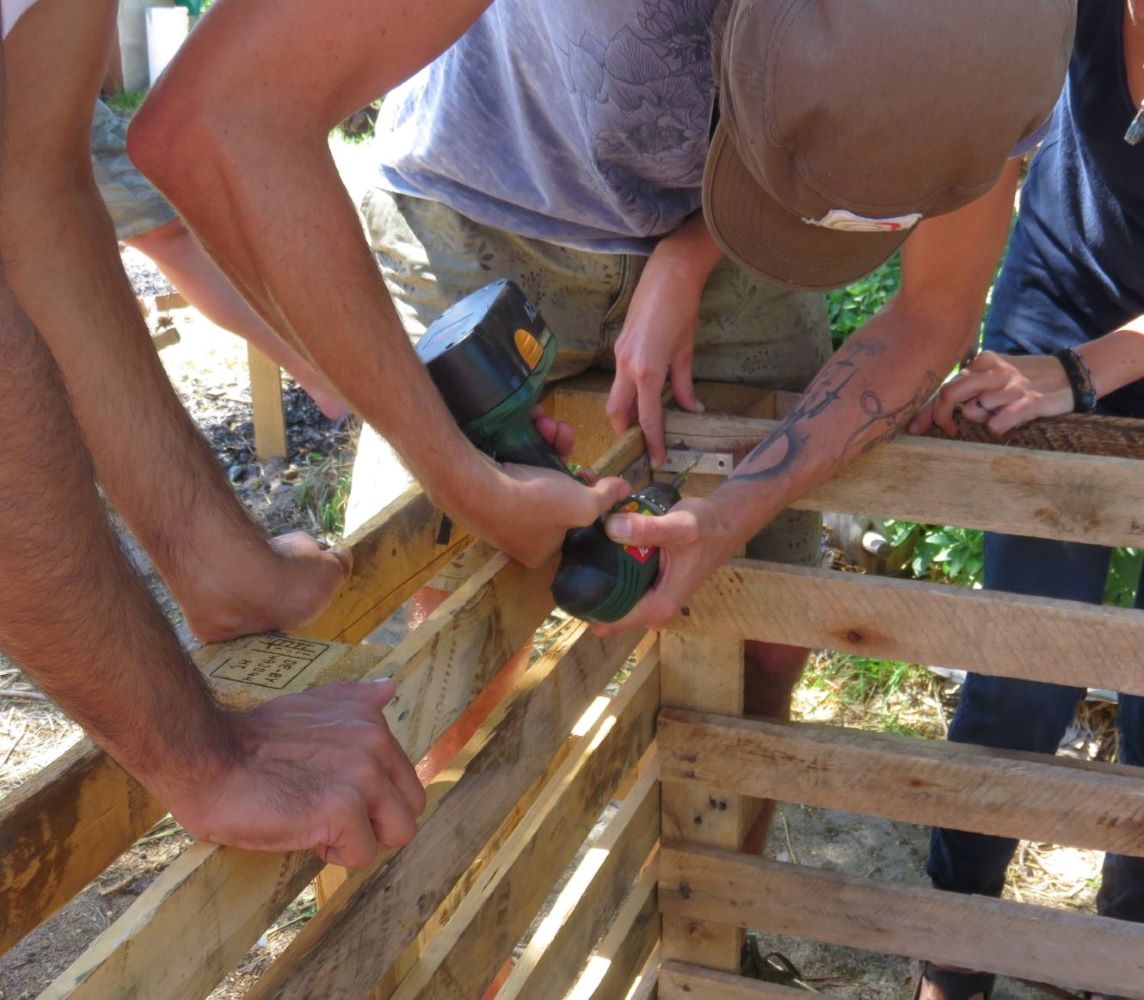 How to save drinking water from becoming black water. Use dry or compost toilets. Here volunteers work on assembling a composting box from pallets.
How to save drinking water from becoming black water. Use dry or compost toilets. Here volunteers work on assembling a composting box from pallets.Dry toilets
The trouble with dry toilets is, in the close confines of urban environments there are some problems. There are both cultural and health barriers, suspicious or angry neigbours, persistent UTI's for some, and the possibility of spreading plagues of waterborne 'crowd' diseases if its not properly done. Advocates of compost toilets deny the health risks vociferously. I find that an astronomically high, impractical level of cleanliness, and quite an expert level of knowledge is needed to make it safe. I think a composting service done by professionals may work very well in the urban setting. Buckets of human waste would be picked up and clean buckets delivered. A Johannesburg business has done this for years.
I am working on solutions for our home. We have been through the bucket-to-hot-compost system, and out the other side. It is revolutionary, and yet its so hands on that it gets cumbersome if you don't have time. Total cleanliness is hard to maintain, the pathogens are invisible on the hands and equipment, you never know if you've cleaned enough. Chronic UTI's dogged both my husband and I while the process was used. Neigbours complained about the smell that spread for about ten minutes after emptying the buckets. They complained about flies although there are actually less than there were previously, when we were composting horse manure. However it is possible that tiny traces of fecal chemicals in the air brought flies. They can travel for miles on a scent trail. We are under pressure because the process is not legal and we have to comply immediately to neighbourly requests before they call the authorities. I think they expect us to use toxic chemical warfare on the flies, as that is what they know. Reducing them organically is more effective, but takes time. Explaining only slowly brings a change in attitude. There is the tension of an ideological battle which leaves me feeling alone and alienated.
But if I have these issues to deal with, I'm sure I'm not alone. That is why I'm working on the next, more compact model for indoor
biological processing where there is never a whiff of anything, not even for ten minutes a fortnight. One of the reasons I write is to reach a supportive community outside my immediate neighbourhood.
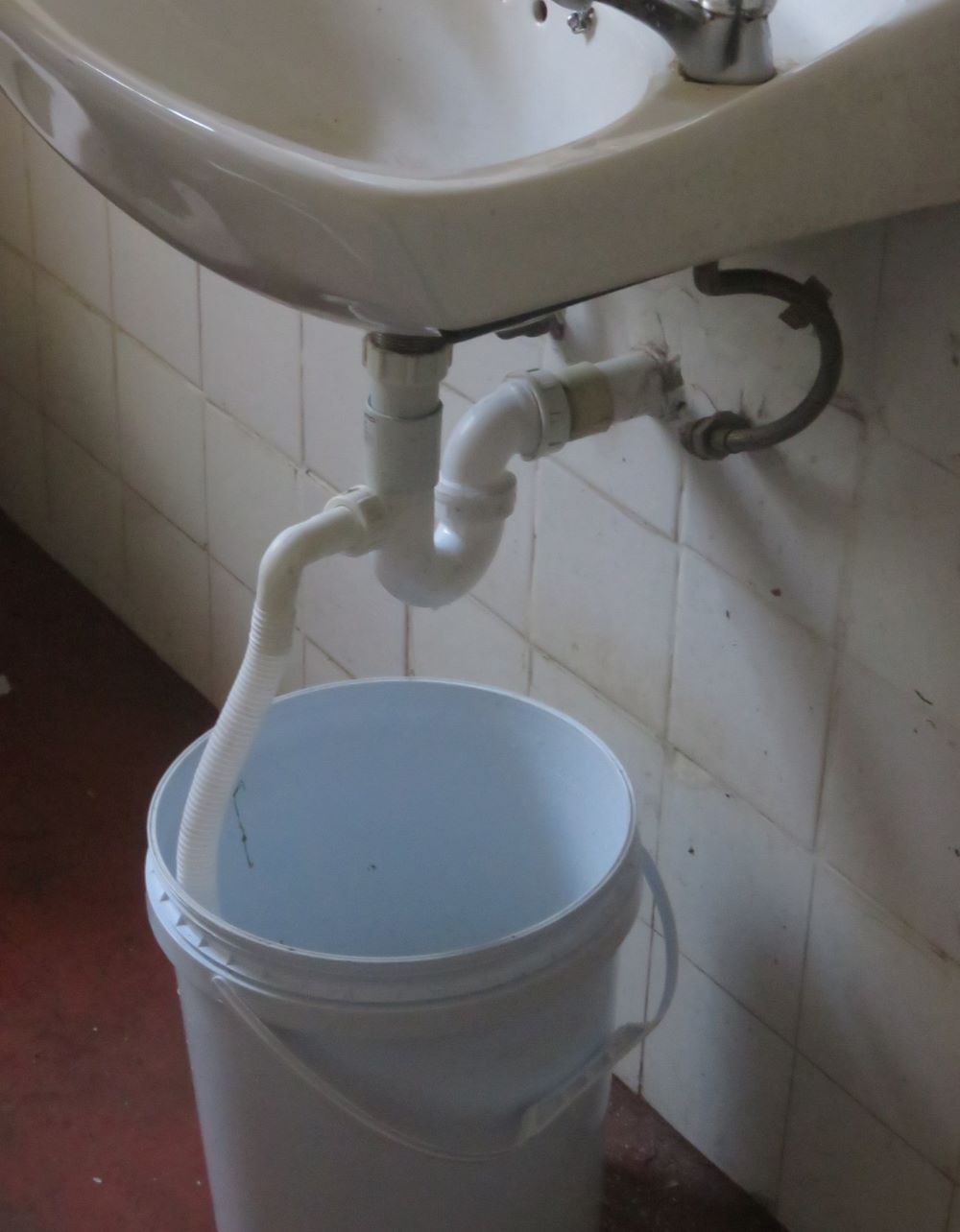 How to save water in the bathroom. Save the hand washing water for flushing the toilet with this simple hack.
How to save water in the bathroom. Save the hand washing water for flushing the toilet with this simple hack.Grey water
This leaves us with the grey water
stream. As a major component of the waste stream, but with less
problematic contamination than the black water, it begs to be
harnessed, recycled and thus help to reduce water consumption. It can comprise a half to over a half of normal waste water and recycling can thus reduce water consumption by a half. Processing the grey water and returning it to the earth are a vital part of a holistic water conservation plan in the home. I expand on grey water recycling in another article. My book on the DIY grey water wetland you can find at the top of the right side bar. It goes into greater depth on the process of cleaning grey water before it is released, and the reasons for doing so.
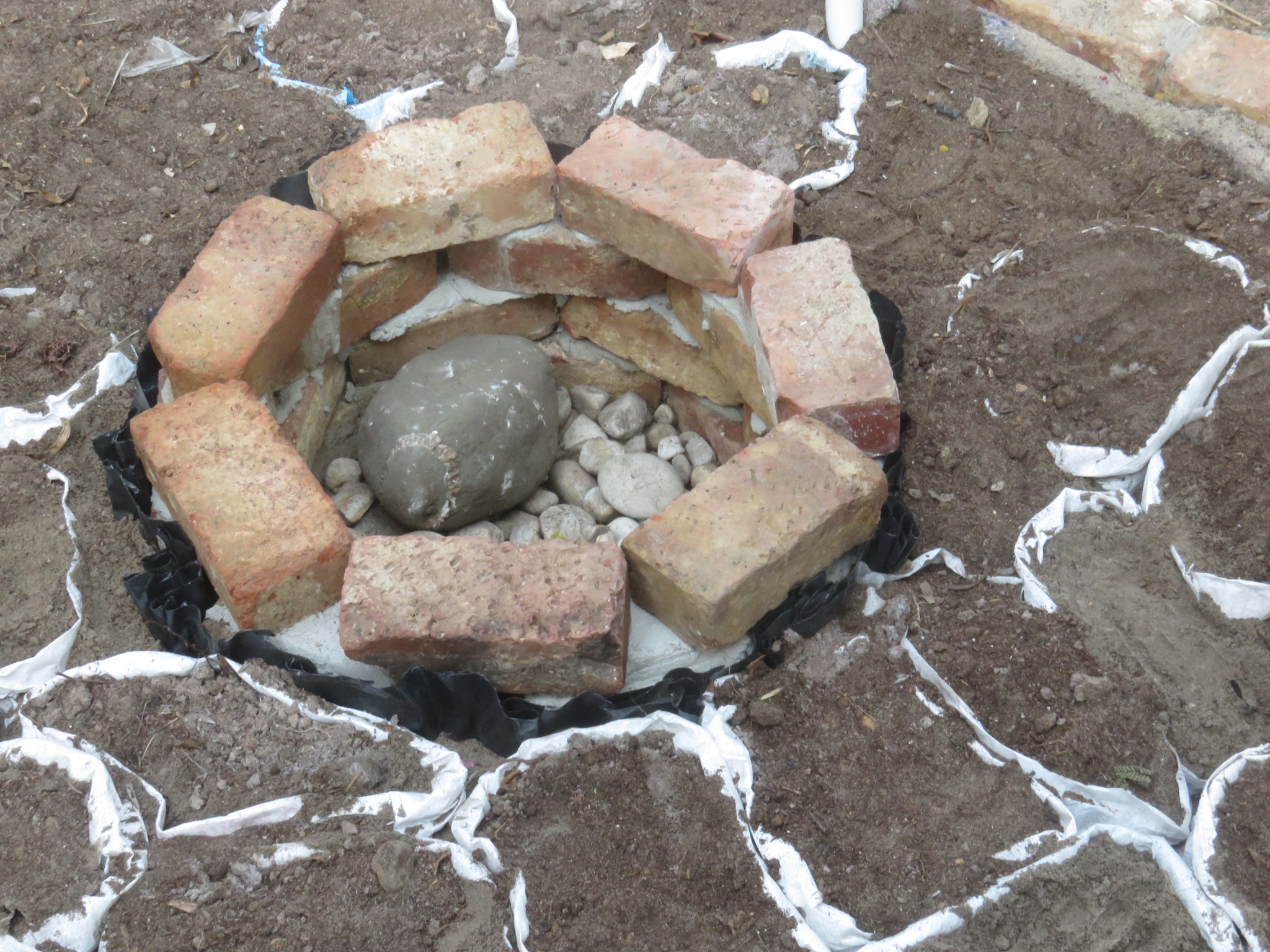 An in ground grey water recycling wetland before planting.
An in ground grey water recycling wetland before planting.What advice can you share to help the world save water ?
------
home page for copious links to articles on natural and permaculture inspired gardening
------
water conservation page with links to articles on water
You’re a home gardener ! Share your experiences and questions !
We all know about home gardening. Tell us about your successes, challenges and ask about issues that bother you. You may have the luxury of a back garden, but there are other ways we learn. Few people age without growing something or buying vegetables during their lives ! It is absolutely guaranteed that you have learned things which can help others on their gardening journey.
We invite you to share your stories, ask questions, because if a thing has bothered you it will bother others too. Someone may have a solution ! No question is too small. There is learning for everyone involved, for you, for me (yes, I learn from every question), for us all. Exciting stuff !
We are starting on a new journey. Every week we will profile your letters ! The best stories and questions we receive.
Restore Nature Newsletter
I've been writing for four years now and I would love to hear from you
Please let me know if you have any questions, comments or stories to share on gardening, permaculture, regenerative agriculture, food forests, natural gardening, do nothing gardening, observations about pests and diseases, foraging, dealing with and using weeds constructively, composting and going offgrid.
SEARCH
Order the Kindle E-book for the SPECIAL PRICE of only
Prices valid till 30.09.2023
Recent Articles
-
garden for life is a blog about saving the earth one garden at a time
Apr 18, 25 01:18 PM
The garden for life blog has short articles on gardening for biodiversity with native plants and regenerating soil for climate amelioration and nutritious food -
Cape Flats Sand Fynbos, Cape Town's most endangered native vegetation!
Apr 18, 25 10:36 AM
Cape Flats Sand Fynbos, a vegetation type found in the super diverse Cape Fynbos region is threatened by Cape Town's urban development and invasive alien plants -
Geography Research Task
Jan 31, 25 11:37 PM
To whom it may concern My name is Tanyaradzwa Madziwa and I am a matric student at Springfield Convent School. As part of our geography syllabus for this
"How to start a profitable worm business on a shoestring budget
Order a printed copy from "Amazon" at the SPECIAL PRICE of only
or a digital version from the "Kindle" store at the SPECIAL PRICE of only
Prices valid till 30.09.2023







